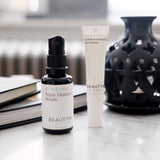
There's a whole world of exfoliation out there, and it isn't just limited to scrubbing away at your skin. Instead, there are other exfoliants that can be applied to the skin to encourage cell turnover and removal of dead skin cells.
Today's post focuses on two different chemical face peels: ones containing glycolic acid, and enzyme peels, which are sometimes called fruit or natural peels.
Glycolic at a Glance
Glycolic acids are alpha hydroxy acids (AHAs) naturally found in sugar cane. Glycolic acids stimulate exfoliation from the inside out. When applied to the skin, the glycolic acid penetrates the skin and dissolves the bonds that hold dead skin cells onto new, healthy skin cells. In addition to this benefit, glycolic acid's presence also stimulates the skin to form new, healthy skin cells.
Enzymes at a Glance
Enzymes are found naturally in many fruits. Examples include the enzyme papain, which comes from papayas, and bromelain, which comes from pineapples. Unlike acids, enzymes are activated by water. They break down the proteins found in the skin, which helps to make it softer. Enzymes can also help to break down some of the bonds on the outermost layers of skin, which can loosen some dead skin cells.
Choosing the Chemical Face Peel for You
Now that you know a little about each chemical face peel option, it's time to put the two options in head-to-head competition.
Effectiveness
Effectiveness is likely one of the most important considerations when picking an at-home chemical peel. In the battle of enzymes versus glycolic acid, the latter emerges the victor. This is because glycolic acid is the multi-tasker of the exfoliating world: it encourages new skin cells to grow (which has anti-aging effects) and smoothes the skin by penetrating to deeper layers than enzymes can. While enzyme peels may soften the skin, glycolic acid takes these results a step further by softening the skin and also brightening it.
Progressive Abilities
Glycolic acid can be adjusted to increase the level of exfoliation a person achieves over time. For example, the initial phase of The Progressive Peel involves applying an 8 percent exfoliating serum. Ultimately, a person will "graduate" to a 15 percent exfoliating cream.
Enzyme peels do not have this adjustability. As a result, you may not notice true improvements in your skin over time.
Product Stability
Enzymes can be temperamental to control when added to skincare products. They must be stored in an optimal manner: no moisture, heat, or pH changes. Otherwise, the enzymes start to inactivate and become ineffective at exfoliating. Unfortunately, the only way to know that an enzyme product has broken down is when you stop seeing results.
When Dr. Neal Schultz set out to create The Progressive Peel, containing glycolic acid, he paid careful attention to how the acid was prepared and packaged. This attention to detail results in a product that is highly stable on a shelf for a longer effectiveness period.
The Verdict:
For effectiveness, progressive abilities, and product stability, glycolic acid wins this, "Battle of the Peels."
References:
The International Dermal Institute: Methods of Exfoliation
Self: What Do Enzymes Do For Your Skin?
 BRX REWARDS
BRX REWARDS





















@Sonia Bartels I had something similar. I went to an esthetician and learned it was called milia. Basically acne that forms under the skin.
I have small white bumps, undetectable to the eye, but I see them. Almost growing under my layer of skin. I just got the undereye exfoilator in hopes that it will help? Is this the right thing to do?